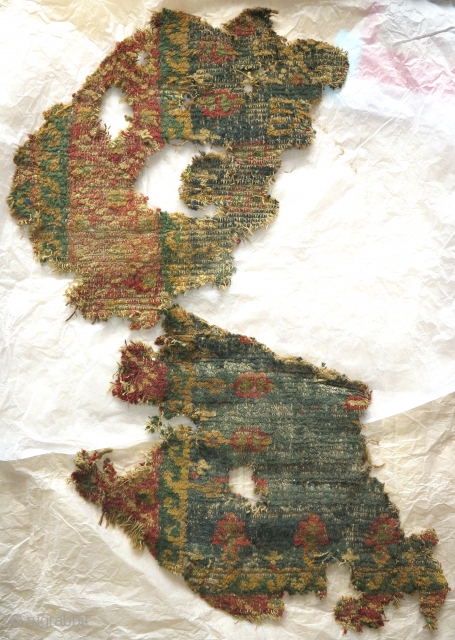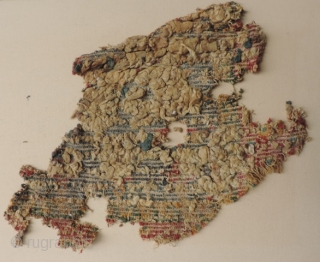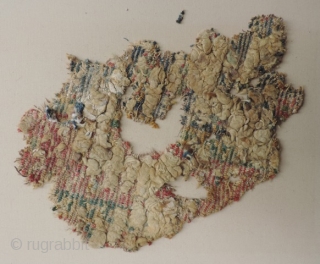Back
Two more Ancient Carpet Fragment, 3rd - 6th century. Part of the same group of early pile carpet fragments seen in the Al-Sabah Collection. (See Friedrich Spuhler, Pre-Islamic Carpets and Textiles from Eastern Lands (Al-Sabah Collection)" This weaving group is described in that publication as being from "Eastern Iran" and from the "Sasanian Period". Provenance is given as "reportedly Samgan Province, northern Afghanistan". However, the only conclusive excavation spot for this distinctive material that i know of is Loulan in Xinjiang. While the dating for this material is likely correct, a "Sasanian" description is thus less certain. Indeed, the animal imagery seen within this group seems particularly devoid of Sasanian iconographic conventions or related Bactrian or even Sogdian models. More likely this ditinctive group is from a weaving center in eastern Central Asia within the current political borders of Xinjiang province.
i found the following article in the journal of the v&a by Swati Venkatraman Iyer who makes a well reasoned and convincing argument for the origin of the group...
i found the following article in the journal of the v&a by Swati Venkatraman Iyer who makes a well reasoned and convincing argument for the origin of the group...
http://www.vam.ac.uk/content/journals/research-journal/issue-no.-7-autum...
Interestingly, the red/pink seen in these two particular fragments reads as either lac or another insect derived dye. The vast majority of other fragments from the group seem to use a madder red.
price:
SOLD
- Home
- Antique Rugs by Region
- Category
- Profiles
- Post Items Free
- Albums
- Benaki Museum of Islamic Art
- Budapest: Ottoman Carpets
- Gulbenkian Museum
- Islamic Carpets. Brooklyn
- Islamic Textiles. Brooklyn
- Konya Museum: Rugs
- MKG, Hamburg
- MMA: Caucasian Carpets
- MMA: Mamluk Carpets
- MMA: Mughal Indian Carpets
- MMA: Ottoman Carpets
- MMA: Safavid Persian Carpets
- MMA: Turkmen Rugs
- McCoy Jones Kilims
- Ottoman textiles. Met
- Philadelphia Museum
- Rugs and Carpets: Berlin
- Seljuqs at the Met
- TIEM, Istanbul: Carpets
- V&A: Classical Carpets
- Vakiflar Carpets: Istanbul
- Baluch Rugs: Indianapolis
- Gallery Exhibitions
- Jaf an Exhibition
- Alberto Levi Gallery
- Andean Textile
- Christie's London: 2016
- Francesca Galloway
- HALI at 40
- ICOC Washington, DC 2018
- Jajims of the Shahsavan
- London Islamic Week April, 2018
- Mongolian Felts
- Navajo Rugs: JB Moore
- Persian Piled Weavings
- SF Tribal & Textile Art Show 2020
- SF Tribal 2019
- Sotheby's: C. Alexander
- Turkish Prayer Rugs
- Turkmen Main Carpets ICOC 2007












